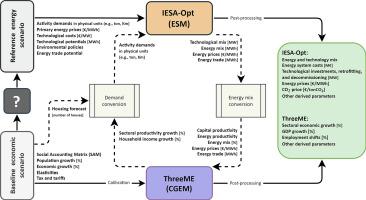Energy Economics ( IF 12.8 ) Pub Date : 2023-05-24 , DOI: 10.1016/j.eneco.2023.106750 Amirhossein Fattahi , Frédéric Reynès , Bob van der Zwaan , Jos Sijm , André Faaij

|
Top-down CGE models are used to assess the economic impacts of climate change policies. However, these models do not represent the technologies and sources of greenhouse gas emissions as detailed as bottom-up energy system models. Linking a top-down CGE model with a bottom-up energy system model assures macroeconomic consistency while accounting for a detailed representation of energy and emission flows. While there is ample literature regarding the linking process, the corresponding details and underlying assumptions are barely described in detail. The present paper describes a step-by-step soft-linking process and its underlying assumptions, using the Netherlands as a case study. This soft-linking process increases the Dutch energy demand levels in 2050 by 19.5% on average compared to assumed exogenous levels. Moreover, the GDP in 2050 reduces by 5.5% compared to the baseline economic scenario. Furthermore, we identified high energy prices as the primary cause of this GDP reduction in the soft-linking process.
中文翻译:

将国家可计算一般均衡模型 (ThreeME) 与详细的能源系统模型 (IESA-Opt) 软链接
自上而下的 CGE 模型用于评估气候变化政策的经济影响。然而,这些模型并不像自下而上的能源系统模型那样详细地代表温室气体排放的技术和来源。将自上而下的 CGE 模型与自下而上的能源系统模型联系起来,确保宏观经济的一致性,同时考虑能源和排放流的详细表示。虽然有大量关于链接过程的文献,但几乎没有详细描述相应的细节和基本假设。本文以荷兰为例,描述了一个循序渐进的软链接过程及其基本假设。与假设的外生水平相比,这种软连接过程使荷兰 2050 年的能源需求水平平均增加 19.5%。而且,与基准经济情景相比,2050 年的 GDP 减少 5.5%。此外,我们将高能源价格确定为软连接过程中 GDP 下降的主要原因。



























 京公网安备 11010802027423号
京公网安备 11010802027423号